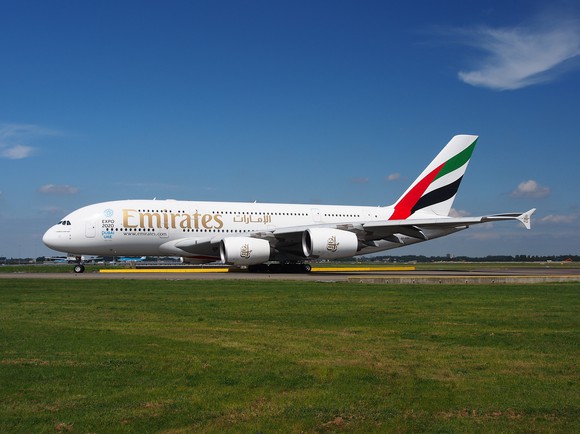Global airline giant Emirates has had to curtail its once-rapid growth in recent years, as volatile fuel prices, stiff competition, and weak economic growth in parts of the world have weighed on its profitability. In its recently ended 2019 fiscal year, Emirates grew capacity just 3%, with the aim of improving its pricing power so it could raise fares. Nevertheless, the airline's profit plummeted 69%, as Emirates failed to fully offset a sharp rise in fuel costs.
This deterioration in financial performance highlights the danger of Emirates' reliance on the Airbus (EADSY +0.16%) A380 jumbo jet. Emirates' recent move to cancel most of its remaining A380 orders in favor of smaller Airbus and Boeing (BA +0.47%) widebodies should allow it to gradually rebuild its profit margin over time.
The A380 is the problem
In fiscal 2019, Emirates' main airline subsidiary earned $237 million on $26.7 billion of revenue. That put its profit margin at a meager 0.9%. For comparison, just three years earlier, Emirates earned $1.9 billion and had an 8.4% profit margin.
The main difference between then and now is that oil prices were at their nadir during Emirates' 2016 fiscal year. Oil prices have rebounded since then, driving a 56% jump in the airline's fuel costs over the past three years, despite modest capacity growth. Fuel accounted for 32% of Emirates' operating costs last year, more than any other expense item.
The Airbus A380's high fuel consumption has exacerbated this headwind. Its massive size, four-engine design, and relatively low seating density combine to make it burn more fuel per seat than smaller widebody jets -- even older models like the Boeing 767 and Airbus A330. Not surprisingly, state-of-the-art jets like Boeing's 787 Dreamliner family and Airbus' A350 have even bigger fuel-efficiency advantages over the A380.

To make matters worse, it's hard to fill an A380 because of the type's massive seating capacity. In fiscal 2019, Emirates' load factor -- the percentage of seats filled with paying customers -- fell to 76.8% from 77.5% a year earlier. For comparison, U.S. global airline United Continental recorded an 81.3% load factor on its international flights last year.
Emirates is finally addressing the issue
It's hard to decipher how much Emirates' current financial woes are affecting its fleet planning decisions. Nevertheless, the carrier's recent decision to cancel 39 A380 orders -- leaving it with just 14 more A380s on order -- represents the first step in returning Emirates to health.
In conjunction with this order cancellation, Emirates agreed to buy 40 A330-900neos and 30 A350-900s. It also has 150 Boeing 777X jets on order. Emirates no longer plans to finalize a previous commitment to buy 40 787-10s, as those planes were to fill the role that will be covered by the A330-900neos and A350s it has ordered.
Some of these jets on order will be used to pursue growth opportunities in the coming years. But many are destined to replace older aircraft in the Emirates fleet. The Boeing 777X in particular will be Emirates' primary replacement for the A380.
Emirates' first A380 leases expire next year, and the airline is likely to start retiring the oldest of its jumbo jets then. Based on the age of its fleet, the rate of A380 retirements will accelerate in the mid-2020s.
Killing two birds with one stone
Boeing's 777X-family jets will generally offer a double-digit reduction in fuel burn per seat compared with the Airbus A380. The exact savings depends on how many seats are installed on each aircraft. Emirates' A380 configurations range from 489 seats to 615.
In addition, the 777X is quite a bit smaller than the A380. Boeing says the larger 777-9 model will seat 400 to 425 passengers in a typical configuration. As a result, swapping some of its A380s for 777-9s should help Emirates to improve its load factor over time. With fewer seats available on some routes, Emirates would also potentially be able to boost its average fare.
It will take some time for this fleet transition to have a major impact on Emirates' financial results. But over the next decade, Emirates is likely to phase out the majority of its A380 fleet in favor of smaller, more fuel-efficient aircraft, making itself a more sustainable business.
